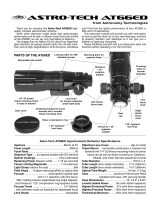Step-1
Find a distant object in the
telescope with a low
power eyepiece.
Step-2
Align the finderscope by
pointing at the same
object, then loosen or
tighten the alignment
screws.
Step-3
Use a high power
eyepiece and repeat this
procedure.
Connection Instructions
( Aligning Finderscope )
Align the finderscope pointing at the same object as the telescope.
View Field of Telescope.
Alignment Screws.
View Field of Finderscope.
(with WO Erecting Illuminated
Finderscope)
P07
w w w . w i l l i a m - o p t i c s . c o m
P08
C r a f t i n g t h e E a r t h ' s F i n e s t
A s t r o n o m i c a l I n s t r u m e n t s
o
o
oo
Usage
The Fluorostar 110 is designed to work with both 1 1/4 inch and 2 inch diameter eyepieces in
various focal lengths, for both daytime and nighttime viewing. Because the Fluorostar 110 is well
suited to viewing nebulae, clusters, large galaxies and comets, we recommend the use of high
quality wide angle eyepieces. The WO SWAN ( 72 ) and UWAN ( 82 ) series eyepieces are
available in a variety of focal lengths. Viewing the moon and planets is also impressive at
magnifications of 120X when seeing conditions permit.
This telescope is also well suited for higher power observations with planetary eyepieces.
To calculate the magnification of your telescope and eyepiece combination, divide the telescope
focal length in mm by the eyepiece focal length in mm.
Keep in mind that the atmosphere plays an important role in seeing conditions, and only the
best seeing conditions will support high power viewing. Additional power under less than ideal
seeing conditions will not result in an increase in viewable details, and lower powered eyepieces
should there be used under those conditions. It's easiest to locate objects using low power
eyepieces (20X magnification) and then zoom in by switching to higher powered eyepieces. The
largest field of view will be seen using a 12X low power-wide field of view eyepiece. Also
remember to let the telescope reach thermal stability for optimal results. A triplet lens takes
longer than a doublet to cool down. A stable tripod or mount is recommended for optimal
viewing. This includes high quality photography tripods, and German Equatorial mounts, which
are designed for astronomical use and include precise tracking of celestial objects. William
Optics is marketing a very practical Alt-Az mount too, which will perfectly complement any of its
refractors.
The Fluorostar 110 has been specifically designed for astrophotography; it will produce excellent
results when used with the proper equipment. Being this a high-end astrophotography
telescope, it should be mounted on a good mount. Please see our website for examples of
photos taken with these telescopes. The Accessories Chart on page 3 provides additional
details on photographic accessories for various CCD, digital and film cameras.
Optional accessories from WO include mounting rings and plates, super high-quality 2" Quartz
star diagonals, and 2" Erecting Prisms (45 and 90 ), all of which provide for superior viewing
and high quality images.
Never aim your telescope or finderscope at the Sun without proper Solar filters installed on the
front of the telescope. Doing so for even a moment may permanently damage your vision.
Proper Solar filters consist of a filters made by reputable manufacturers, designed to fit tightly
over the front of the dew shield. Solar eyepiece filters are not considered safe, and should not
be used. With proper front mounted Solar filters, the telescope will not be harmed by viewing the
Sun. Contact your Authorized WO Dealer for further information on the brands, sizes, and prices
of proper solar filters.



































